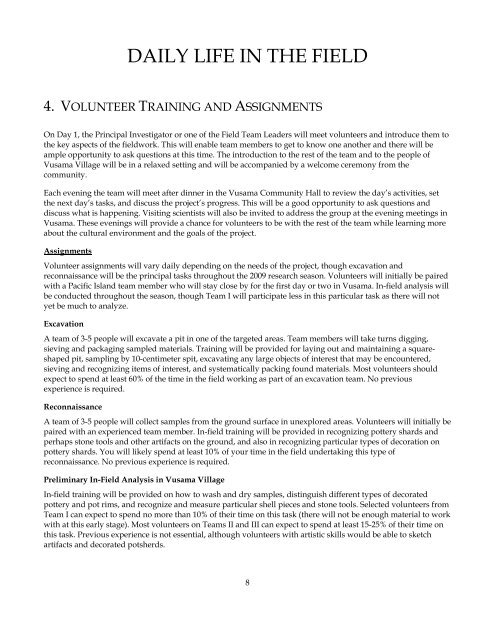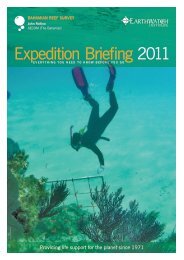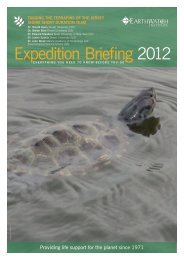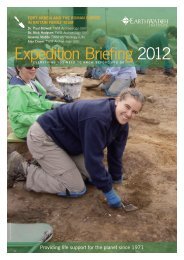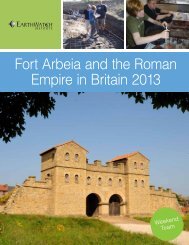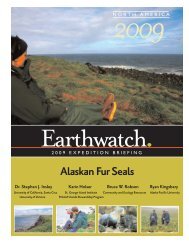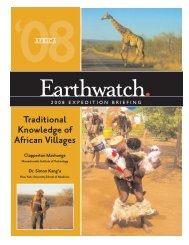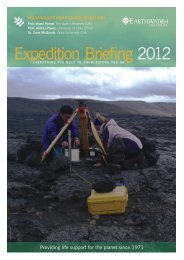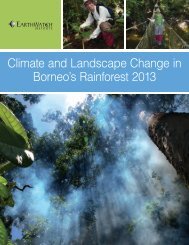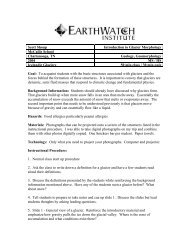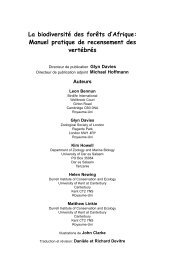Fiji's Ancient Seafarers Dr. Patrick D. Nunn - Earthwatch Institute
Fiji's Ancient Seafarers Dr. Patrick D. Nunn - Earthwatch Institute
Fiji's Ancient Seafarers Dr. Patrick D. Nunn - Earthwatch Institute
You also want an ePaper? Increase the reach of your titles
YUMPU automatically turns print PDFs into web optimized ePapers that Google loves.
DAILY LIFE IN THE FIELD<br />
4. VOLUNTEER TRAINING AND ASSIGNMENTS<br />
On Day 1, the Principal Investigator or one of the Field Team Leaders will meet volunteers and introduce them to<br />
the key aspects of the fieldwork. This will enable team members to get to know one another and there will be<br />
ample opportunity to ask questions at this time. The introduction to the rest of the team and to the people of<br />
Vusama Village will be in a relaxed setting and will be accompanied by a welcome ceremony from the<br />
community.<br />
Each evening the team will meet after dinner in the Vusama Community Hall to review the day’s activities, set<br />
the next day’s tasks, and discuss the project’s progress. This will be a good opportunity to ask questions and<br />
discuss what is happening. Visiting scientists will also be invited to address the group at the evening meetings in<br />
Vusama. These evenings will provide a chance for volunteers to be with the rest of the team while learning more<br />
about the cultural environment and the goals of the project.<br />
Assignments<br />
Volunteer assignments will vary daily depending on the needs of the project, though excavation and<br />
reconnaissance will be the principal tasks throughout the 2009 research season. Volunteers will initially be paired<br />
with a Pacific Island team member who will stay close by for the first day or two in Vusama. In-field analysis will<br />
be conducted throughout the season, though Team I will participate less in this particular task as there will not<br />
yet be much to analyze.<br />
Excavation<br />
A team of 3-5 people will excavate a pit in one of the targeted areas. Team members will take turns digging,<br />
sieving and packaging sampled materials. Training will be provided for laying out and maintaining a squareshaped<br />
pit, sampling by 10-centimeter spit, excavating any large objects of interest that may be encountered,<br />
sieving and recognizing items of interest, and systematically packing found materials. Most volunteers should<br />
expect to spend at least 60% of the time in the field working as part of an excavation team. No previous<br />
experience is required.<br />
Reconnaissance<br />
A team of 3-5 people will collect samples from the ground surface in unexplored areas. Volunteers will initially be<br />
paired with an experienced team member. In-field training will be provided in recognizing pottery shards and<br />
perhaps stone tools and other artifacts on the ground, and also in recognizing particular types of decoration on<br />
pottery shards. You will likely spend at least 10% of your time in the field undertaking this type of<br />
reconnaissance. No previous experience is required.<br />
Preliminary In-Field Analysis in Vusama Village<br />
In-field training will be provided on how to wash and dry samples, distinguish different types of decorated<br />
pottery and pot rims, and recognize and measure particular shell pieces and stone tools. Selected volunteers from<br />
Team I can expect to spend no more than 10% of their time on this task (there will not be enough material to work<br />
with at this early stage). Most volunteers on Teams II and III can expect to spend at least 15-25% of their time on<br />
this task. Previous experience is not essential, although volunteers with artistic skills would be able to sketch<br />
artifacts and decorated potsherds.<br />
8


